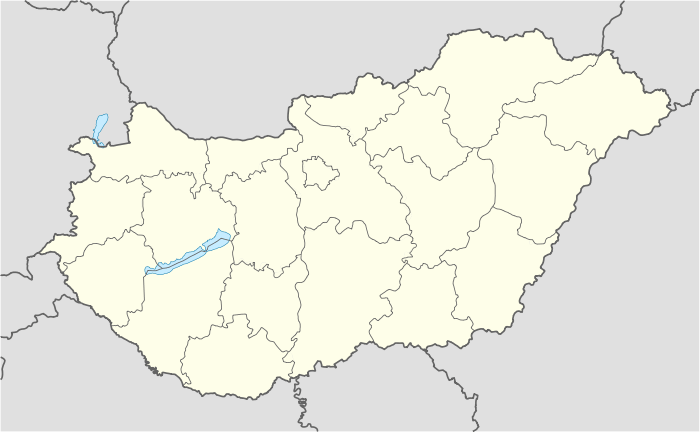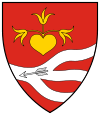Gyomaendrőd
| Gyomaendrőd | ||
|---|---|---|
|
Town hall | ||
| ||
 Gyomaendrőd | ||
| Coordinates: 46°56′10″N 20°49′25″E / 46.93611°N 20.82361°ECoordinates: 46°56′10″N 20°49′25″E / 46.93611°N 20.82361°E | ||
| Country |
| |
| County | Békés | |
| Area | ||
| • Total | 303.98 km2 (117.37 sq mi) | |
| Population (2011) | ||
| • Total | 13,680 | |
| • Density | 49.66/km2 (128.6/sq mi) | |
| Time zone | CET (UTC+1) | |
| • Summer (DST) | CEST (UTC+2) | |
| Postal code | 5500, 5502 | |
| Area code(s) | 66 | |
Gyomaendrőd is a town in Békés county, Hungary.
Name
Gyoma is an old Hungarian male given name,[1] while Endrőd means "belongs to Endre (Hungarian to Andrew)" or "property of Endre".
Geography
Gyomaendrőd is located in the Great Hungarian Plain upon the river Körös, 177 km (110 mi) southeast from Budapest. Highway 46, 443 and Budapest-Szolnok-Békéscsaba-Lökösháza high speed (120–160 km/h (75–99 mph)) railway line also cross the town.[2]
History
The smaller towns of Gyoma and Endrőd were united in 1982.[3] Gyoma was first mentioned in 1332, while Endrőd in 1416.[3] Medieval towns were ruined due to the Ottoman wars, native Hungarian population fled from the area.[4] It was uninhabited until the early 18th century, when Calvinist Hungarians reestablished Gyoma. Calvinist church was built from 1791 to 1813.[3] Gyoma was rebuilt by Roman Catholic Slovaks and Hungarians from Upper Hungary.[4] Slovaks adopted Hungarian language and assimilated into the Hungarian majority by the 19th century.[4] Lutheran Germans also settled in Gyoma in the early 19th century,[4] their church was built in 1862. In the 20th century Gyomaendrőd became a resort town, the government granted town rights in 1989.[3]
Demographics
According to the 2011 census the total population of Gyomaendrőd was 13,680, of whom there were 11,547 (84.4%) Hungarians, 613 (4.5%) Romani and 163 (1.2%) Germans by ethnicity. 15.6% did not declare their ethnicity,[5] excluding these people Hungarians made up 100% of the total population. In Hungary people can declare more than one ethnicity, so some people declared a minority one along with Hungarian.[6][7]
In 2011 there were 3,458 (25.3%) Roman Catholic, 1,483 (10.8%) Hungarian Reformed (Calvinist) and 183 (1.3%) Lutheran in Gyomaendrőd. 4,644 people (34.0%) were irreligious and 170 (1.2%) Atheist, while 3,602 people (26.3%) did not declare their religion.[6]
Notable people
- János Pásztor (1881-1945), Hungarian sculptor
- Kálmán Rózsahegyi (1873-1961), Hungarian actor
Sister citites
References
- ↑ János Ladó - Ágnes Bíró: Magyar utónévkönyv ("Book of Hungarian given names"), Vince Kiadó, Budapest, 2005, ISBN 963-9069-72-8
- ↑ Magyarország autóatlasz, Dimap-Szarvas, Budapest, 2004, ISBN 963-03-7576-1
- ↑ 3.0 3.1 3.2 3.3 Gyomaendrőd, Tourinform Iroda Gyomaendrőd, 2010, p.33, pp.1-16
- ↑ 4.0 4.1 4.2 4.3 Károly Kocsis (DSc, University of Miskolc) – Zsolt Bottlik (PhD, Budapest University) – Patrik Tátrai: Etnikai térfolyamatok a Kárpát-medence határon túli régióiban, Magyar Tudományos Akadémia (Hungarian Academy of Sciences) – Földrajtudományi Kutatóintézet (Academy of Geographical Studies); Budapest; 2006.; ISBN 963-9545-10-4, CD Atlas
- ↑ Gazetteer of Hungary / Gyomaendrőd
- ↑ 6.0 6.1 2011 Hungarian census, Békés county
- ↑ Hungarian census 2011 - final data and methodology
External links
| |||||||||||||||||||||

